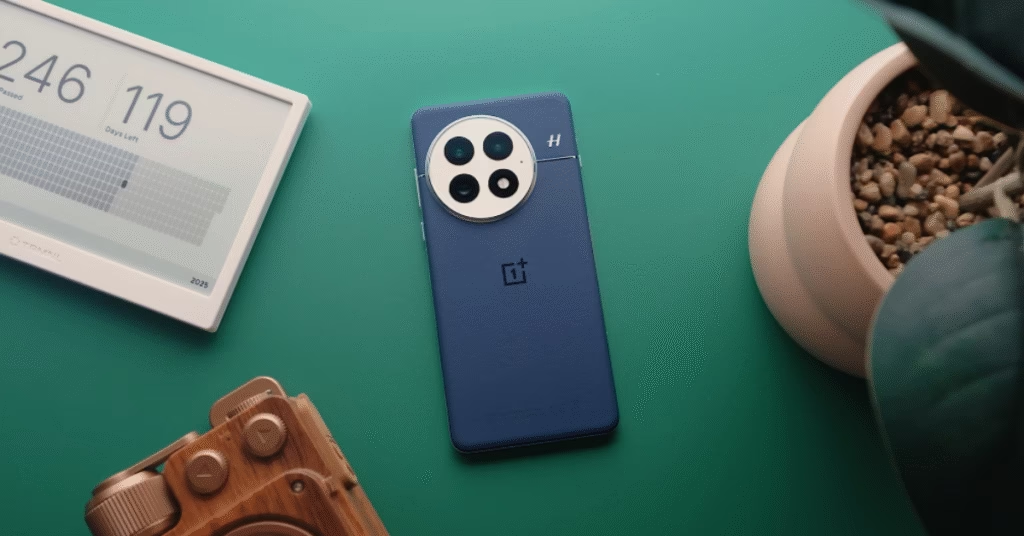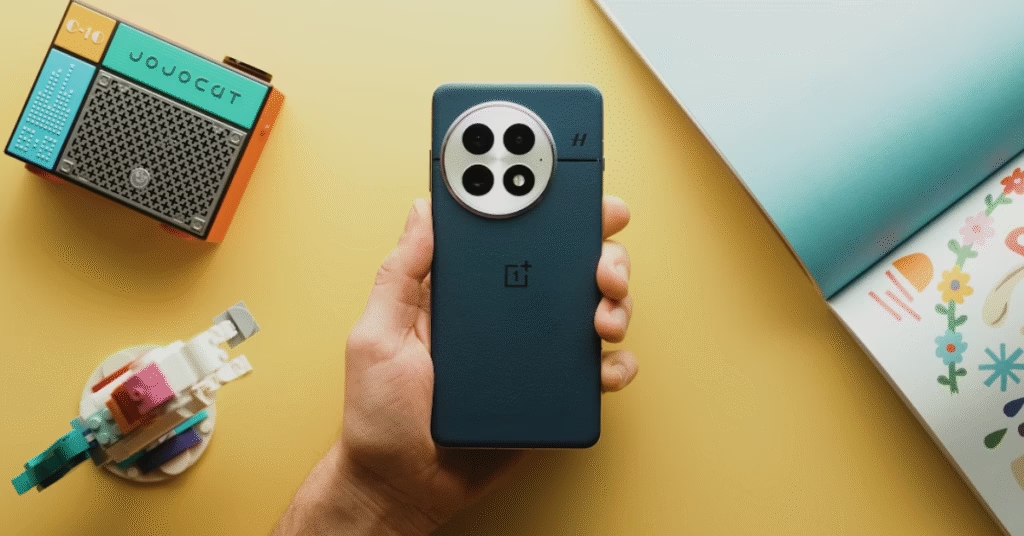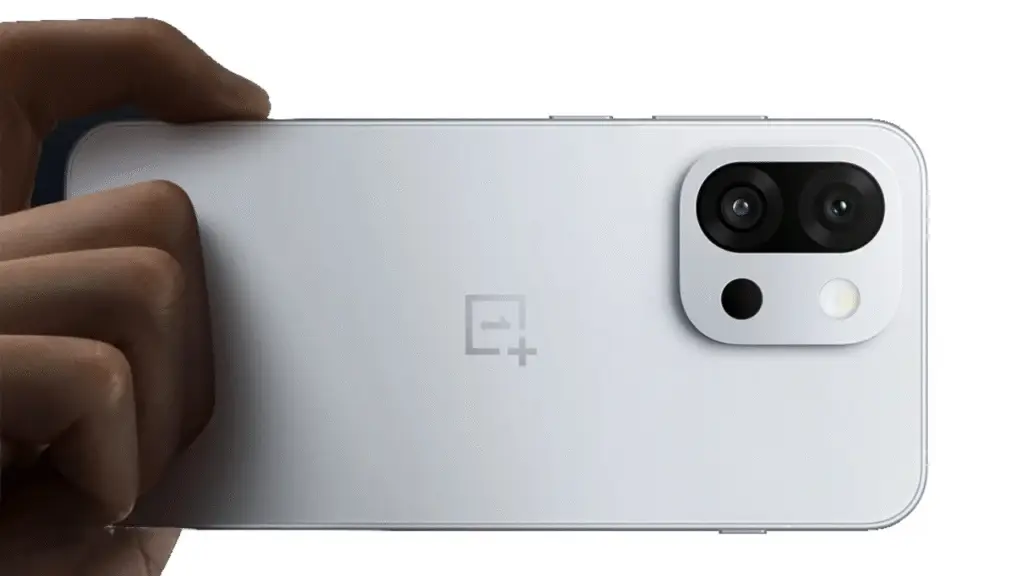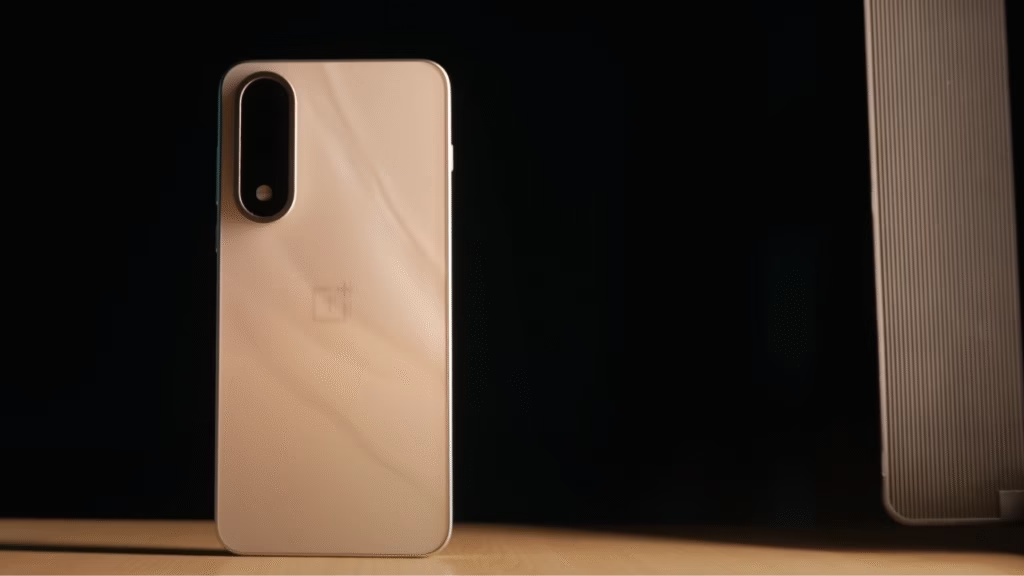
The smartphone market is full of heavy competition, with every major brand trying to deliver the perfect blend of performance, design, and innovation. This year, OnePlus has stepped up once again with its new flagship, the OnePlus 13. While it doesn’t completely reinvent the wheel, it introduces meaningful changes such as a bigger battery, stronger ingress protection, an upgraded chipset, and subtle refinements in design.
In this OnePlus 13 review, we’ll go through the design, display, performance, software, cameras, battery life, and overall user experience to see if this flagship is worth your attention.
Design and Build Quality
At first glance, the OnePlus 13 feels familiar. The off-center circular camera module remains a defining feature, though with a refreshed look this year. Depending on the variant, you’ll either get a vegan leather back (in blue) or glass panels (in black and white). The flat front and back panels give the phone a more industrial look, while the aluminum frame is slightly thicker than before, making it feel solid in hand.
One of the biggest upgrades here is durability. The OnePlus 13 moves up from IP65 protection on the previous model to IP68 and IP69 ratings. That means it’s not only resistant to dust and submersion but can also handle high-pressure water jets and heated sprays. It’s rare to see this level of protection in a mainstream flagship.
As always, the popular alert slider is here. It remains clicky and satisfying, giving users a quick way to switch between sound profiles without fiddling with the screen.

Display
The display specs haven’t changed drastically compared to last year’s model, but that’s not necessarily a bad thing. The OnePlus 13 features a 6.82-inch LTPO OLED panel with QHD resolution and a 120Hz refresh rate. It supports Dolby Vision and HDR10+ for a premium viewing experience.
The switch from Gorilla Glass Victus 2 to Ceramic Guard glass makes the panel tougher. Slim bezels keep the design modern, while sharpness at 510 PPI ensures excellent detail.
However, brightness is one area where the phone falls slightly behind its competitors. In our testing, it reached 800 nits manually and just over 1200 nits in auto mode. That’s bright enough for most conditions, but rival flagships like Samsung’s Galaxy S24 Ultra manage higher peaks.
The adaptive refresh rate is smooth and energy efficient, dropping as low as 1Hz when idling. However, it’s worth noting that high frame rate gaming support is missing this year, which may disappoint mobile gamers who expected 90FPS or higher modes in supported titles.
Audio and Fingerprint Scanner
Stereo speakers on the OnePlus 13 deliver very good sound. They’re louder than the previous generation and produce richer audio, making them great for watching videos or casual gaming without headphones.
Another big improvement is the fingerprint scanner. OnePlus has switched from an optical to an ultrasonic sensor, making it more reliable and accurate. It works well even in less-than-ideal conditions, though using a glass screen protector may reduce sensitivity.
Software: Android 15 with OxygenOS
On the software side, the phone runs OxygenOS 15 on top of Android 15. While OxygenOS has become more similar to Oppo’s ColorOS over the years, it still keeps a few signature touches such as the OnePlus font, red accents, and clean design language.
This year, the phone introduces more AI-driven tools. Features like AI Summary, AI Speak, and AI Writer are context-aware and integrated into the smart sidebar. They help condense long texts, read aloud passages, or draft content quickly. In addition, Google’s Circle to Search and Gemini AI assistant are built in.
OnePlus promises four years of major OS updates and six years of security patches, giving the device long-term software support. That’s a big plus for users who don’t want to switch phones often.
Performance: Snapdragon 8 Elite Power
The OnePlus 13 comes with 256GB, 512GB, or even a massive 1TB of internal storage. RAM options start at 12GB, giving plenty of headroom for multitasking. Like before, there’s no microSD slot for expandable storage.
In benchmarks, the device performs exceptionally well, handling heavy gaming, multitasking, and productivity with ease. Thermal management is decent though under prolonged stress, throttling does occur, which is in line with most flagship devices.
Day-to-day usage feels snappy and fluid, with apps launching quickly and transitions running smoothly. Gamers will enjoy the raw power on tap, though as mentioned earlier, the lack of high frame rate support in some games is a curious limitation.
Battery and Charging
One of the standout upgrades this year is the battery. The OnePlus 13 packs a 6,000mAh cell, up from 5,400mAh on the OnePlus 12. Combined with the energy-efficient Snapdragon 8 Elite, this results in impressive endurance.
In active use testing, the phone lasted over 15 hours, which is excellent for a flagship device with a high-resolution screen.
Charging is handled by 100W wired fast charging. While OnePlus doesn’t include a charger in the box globally, compatible chargers can juice the phone from 0 to 55% in just 15 minutes and a full charge in about 35 minutes. Wireless charging is supported at up to 50W, and OnePlus even offers a magnetic wireless charging accessory as an option.
Cameras: A Triple 50MP Setup
The OnePlus 13 continues with a versatile triple 50MP camera system, telephoto, and ultra-wide. Each sensor brings solid performance, though the setup hasn’t seen major changes compared to the previous model.
- Main Camera: During the day, photos look natural with sharp detail, excellent dynamic range, and well-balanced colors. At night, the camera performs impressively, capturing bright, detailed, and noise-free shots without oversharpening.
- Telephoto Camera: The 3x zoom lens delivers sharp, noise-free images with excellent colors and dynamic range. Portraits look particularly pleasing. However, the inability to focus closely is a drawback. At night, quality drops slightly, with some softness in the shadows.
- Ultra-Wide Camera: Arguably one of the best in the industry, the ultra-wide produces sharp, vibrant images both in daylight and nighttime conditions. Autofocus helps with versatility, making it useful for creative angles.
Selfies come from a 32MP front-facing camera. While colors and dynamic range are good, detail could be better, and autofocus is missing something that would have elevated the experience.
Video recording goes up to 8K with the main sensor and 4K at 60fps across all lenses. Footage is sharp and stable, though some minor shakiness can appear when walking.
Verdict: Should You Buy the OnePlus 13?
The OnePlus 13 doesn’t drastically change the formula but refines it in meaningful ways. It brings the latest Snapdragon chipset, a larger 6,000mAh battery, faster charging options, improved durability, and consistent camera performance.
There are some small drawbacks: the display isn’t as bright as its rivals, high frame rate gaming support is lacking, and the telephoto camera could benefit from closer focusing. But these issues don’t overshadow the phone’s strengths.
If you’re looking for a well-balanced flagship with excellent endurance, reliable performance, and long software support, the OnePlus 13 is one of the best choices in 2025. It may not beat every rival in every metric, but it nails the fundamentals and that makes it a flagship worth recommending.
See Also OnePlus 15 Tipped for Early 2026 Launch, Skipping the ‘14’ Series
FAQs
What is the display size of the OnePlus 13?
The OnePlus 13 has a 6.82-inch LTPO OLED display with QHD resolution and a 120Hz refresh rate.
How good is the battery on the OnePlus 13?
It comes with a 6,000mAh battery that scored 15 hours and 28 minutes of active use, with 100W wired charging and 50W wireless charging.
Does the OnePlus 13 support high frame rate gaming?
No, the phone doesn’t currently support gaming beyond 60fps, which is surprising compared to earlier OnePlus models.
What chipset powers the OnePlus 13?
It runs on the Snapdragon 8 Elite, Qualcomm’s top-tier processor for 2025.
How many years of updates will the OnePlus 13 get?
OnePlus promises 4 years of major OS updates and 6 years of security patches.
What are the main camera specs of the OnePlus 13?
It features three 50MP cameras: a main, an ultra-wide with autofocus, and a 3x telephoto zoom.
Is there expandable storage on the OnePlus 13?
No, the phone comes with up to 1TB of internal storage but doesn’t support microSD expansion.


